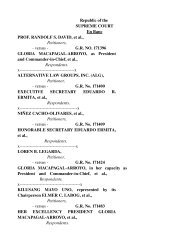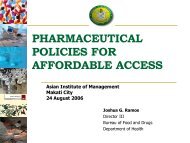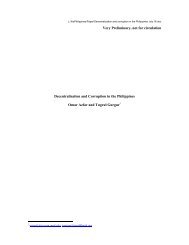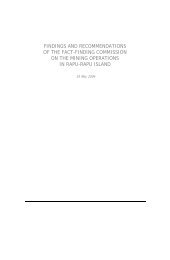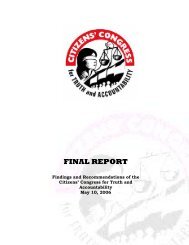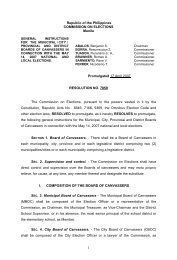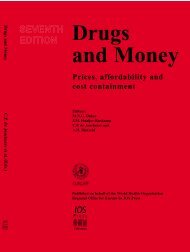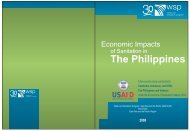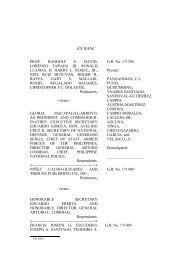The state of water resources in the Philippines - Greenpeace
The state of water resources in the Philippines - Greenpeace
The state of water resources in the Philippines - Greenpeace
You also want an ePaper? Increase the reach of your titles
YUMPU automatically turns print PDFs into web optimized ePapers that Google loves.
treatment and lost <strong>in</strong>come from illness and death due to <strong>water</strong> pollution is pegged<br />
at PHP6.7 billion (US$134 million) per year (PEM 2006).<br />
Pollution <strong>of</strong> our <strong>water</strong> <strong>resources</strong> such as untreated waste<strong>water</strong> discharges affect<br />
human health through <strong>the</strong> spread <strong>of</strong> disease-caus<strong>in</strong>g bacteria and viruses. Some<br />
known examples <strong>of</strong> diseases that may be spread through waste<strong>water</strong> discharge<br />
are gastro-enteritis, diarrhea, typhoid, cholera, dysentery, hepatitis, and, recently,<br />
Severe Acute Respiratory Syndrome (SARS) (PEM 2003).<br />
Accord<strong>in</strong>g to <strong>the</strong> World Bank, just under a third, or 31 percent <strong>of</strong> illnesses <strong>in</strong> <strong>the</strong><br />
country, monitored for a five-year period were caused by <strong>water</strong>-borne pathogens.<br />
In <strong>the</strong> agriculture sector, application <strong>of</strong> agrochemicals (i.e. fertilizers, herbicides,<br />
pesticides) rema<strong>in</strong>s a common practice among farmers <strong>in</strong> rural areas. Intensive<br />
use <strong>of</strong> agrochemicals has been known to create and result to both environmental<br />
problems and diseases. <strong>The</strong> hazards accompany<strong>in</strong>g this practice, especially<br />
those associated with persistent organic pollutants or POPs have been known for<br />
years and <strong>the</strong> knowledge <strong>of</strong> <strong>the</strong> extent <strong>of</strong> harm <strong>the</strong>y cause has <strong>in</strong>creased.<br />
Accord<strong>in</strong>g to a study by Dr. N. Maramba (1996), most farmers may be aware that<br />
pesticides are hazardous but <strong>the</strong>re is a lack <strong>of</strong> awareness <strong>of</strong> exposure risks.<br />
Pesticide handlers are <strong>the</strong> ones most heavily exposed. In addition, exposure <strong>of</strong><br />
households <strong>in</strong> farm<strong>in</strong>g communities may occur due to spray drift from nearby<br />
fields. This exposure is fur<strong>the</strong>r enhanced by farmers’ practice <strong>of</strong> wash<strong>in</strong>g <strong>the</strong>ir<br />
sprayers near, or <strong>in</strong>, irrigation canals, which may <strong>the</strong>n become part <strong>of</strong> agricultural<br />
run<strong>of</strong>f. <strong>The</strong>y also use this <strong>water</strong> source for wash<strong>in</strong>g <strong>of</strong> hands and feet, clo<strong>the</strong>s,<br />
and to some extent, for tak<strong>in</strong>g a bath.<br />
Several cases were cited <strong>in</strong> <strong>the</strong> study concern<strong>in</strong>g organochlor<strong>in</strong>e poison<strong>in</strong>gs,<br />
aplastic anemia, eye, sk<strong>in</strong>, nail, pulmonary, renal, and neurological problems<br />
found to be significantly associated with pesticide exposure.<br />
Maramba’s report fur<strong>the</strong>r mentions that ground<strong>water</strong> near rice paddies may at<br />
times conta<strong>in</strong> pesticide residues. While levels detected were below <strong>the</strong> allowable<br />
limit, this may present long-term chronic exposure problems.<br />
Problems caused by exposure, <strong>the</strong> report stipulates, are fur<strong>the</strong>r aggravated by<br />
<strong>the</strong> fact that very few epidemiological studies on human populations have been<br />
designed to <strong>in</strong>vestigate pesticide exposure and pesticide-related illnesses among<br />
affected populations, result<strong>in</strong>g <strong>in</strong> possible health risks for <strong>the</strong> broader population.<br />
An article by Juan Mercado <strong>in</strong> <strong>the</strong> Philipp<strong>in</strong>e Daily Inquirer last February 22,<br />
2007, highlights <strong>the</strong> threats <strong>of</strong> aerial spray<strong>in</strong>g <strong>of</strong> pesticides over M<strong>in</strong>danao<br />
banana plantations. He mentioned that around 13.5 metric tons <strong>of</strong> toxic mercury<br />
is be<strong>in</strong>g washed yearly <strong>in</strong>to major rivers, from Naboc to K<strong>in</strong>k<strong>in</strong>g, which <strong>the</strong>n flows<br />
<strong>in</strong>to <strong>the</strong> Davao Gulf. Lead tail<strong>in</strong>gs poison <strong>the</strong> Hijo, Matiao, Masara, Batoto, and<br />
Manat Rivers. Mercury-laced <strong>water</strong>s, from Compostela Valley, seep <strong>in</strong>to<br />
tributaries, as <strong>the</strong>y dra<strong>in</strong> <strong>in</strong>to Butuan Bay. Mercury-sta<strong>in</strong>ed stream sediments also<br />
threaten <strong>the</strong> Agusan River.<br />
GREENPEACE | <strong>The</strong> <strong>state</strong> <strong>of</strong> <strong>water</strong> <strong>in</strong> <strong>the</strong> Philipp<strong>in</strong>es 22




